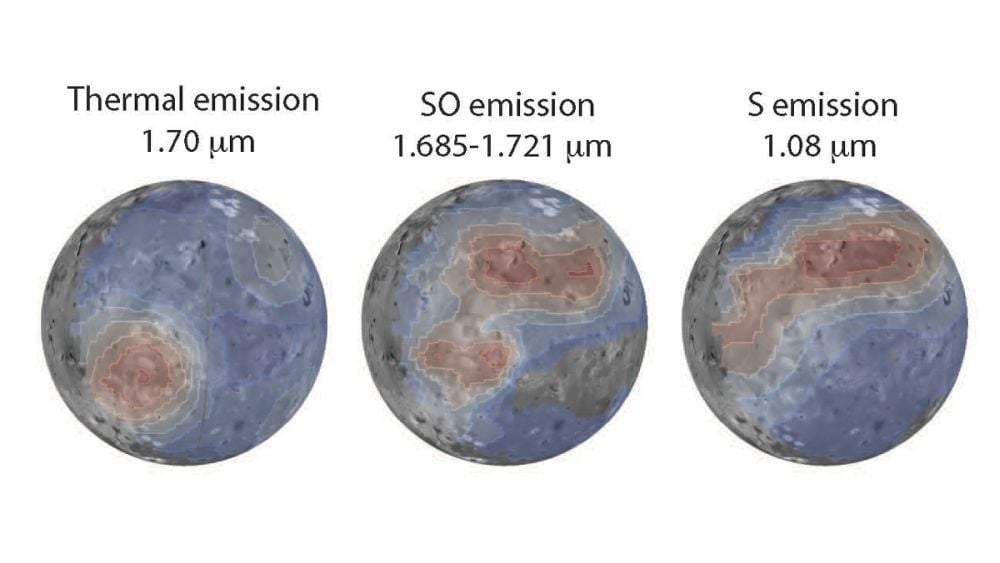Science
JWST Reveals Io’s Intense Volcanic Activity and Unique Atmosphere

The James Webb Space Telescope (JWST) has provided groundbreaking insights into the volcanic activity of Jupiter’s moon Io. Recent observations in 2022 and 2023 have unveiled the complexities of its surface and atmosphere, revealing new data that enhances our understanding of this unique celestial body. The findings were published in the journal JGR Planets, with Imke de Pater, an Astronomy Professor at UC Berkeley, as the lead author.
Unique Volcanic Landscape and Ongoing Research
Io is distinguished by its extraordinary volcanic features, boasting more than 400 active volcanoes and over 100 massive volcanic mountains, some towering higher than Mount Everest. Its surface, rich in sulphur, exhibits vibrant colors of red, yellow, and orange, transformed by volcanic eruptions. Vast lava lakes, including the largest measuring 200 km across, further highlight its dynamic geology.
The intense volcanic activity on Io is driven by a unique gravitational interplay with Jupiter and its three other Galilean moons: Callisto, Ganymede, and Europa. This gravitational tug-of-war creates immense internal heat, fueling Io’s continuous volcanic eruptions.
The JWST observations, which focused on the sulphur emissions associated with these eruptions, marked the first detection of neutral sulphur atoms ([SI]) on Io. This discovery, alongside the identification of sulphur monoxide (SO), enhances our understanding of the processes governing the moon’s volcanic activity.
Insights into Io’s Volcanic Processes
Researchers utilized the JWST’s capabilities to capture detailed images of Io’s surface at different wavelengths. Notably, these observations indicated that the moon’s largest lava lake, Loki Patera, has undergone significant changes, forming a new crust in line with historical volcanic activity patterns. Following a recent eruption in the Kanehekili Fluctus region, lava flows have covered an area exceeding 4,300 square kilometers, expanding fourfold since the eruption.
“The new data illustrate the ongoing relationship between sulphur emissions and volcanic hotspots on Io,” stated de Pater.
Interestingly, the sulphur emissions detected do not originate directly from Io’s volcanoes. Instead, they result from collisional excitation caused by electron impacts from Jupiter’s magnetosphere. This interaction further emphasizes the complex relationship between Io and its massive parent planet, as electrons from Jupiter’s powerful magnetic field interact with sulphur in Io’s atmosphere.
The research findings validate earlier observations from the Hubble Space Telescope, demonstrating that despite continuous volcanic activity, Io’s atmosphere and the surrounding plasma torus remain relatively stable. Excited-state SO molecules were directly linked to volcanic vents, corroborating a two-decade-old hypothesis regarding thermally driven emissions from volcanic outgassing.
Taken together, the new insights reveal a dual influence on Io’s atmosphere, shaped by both volcanic and magnetospheric processes. This unique interaction makes Io the only body in the Solar System where such forces exert such profound effects, underscoring its significance for ongoing astronomical studies.
The findings from the JWST not only enhance our understanding of Io’s geological processes but also highlight the intricate dynamics at play in one of the Solar System’s most fascinating moons. As research continues, Io remains a key focus for scientists aiming to unravel the complexities of planetary volcanism and its broader implications for understanding celestial bodies.
-

 Top Stories2 weeks ago
Top Stories2 weeks agoMarc Buoniconti’s Legacy: 40 Years Later, Lives Transformed
-

 Sports3 weeks ago
Sports3 weeks agoSteve Kerr Supports Jonathan Kuminga After Ejection in Preseason Game
-

 Entertainment3 weeks ago
Entertainment3 weeks agoZoe Saldana Advocates for James Cameron’s Avatar Documentary
-

 Science3 weeks ago
Science3 weeks agoChicago’s Viral ‘Rat Hole’ Likely Created by Squirrel, Study Reveals
-

 Politics3 weeks ago
Politics3 weeks agoDallin H. Oaks Assumes Leadership of Latter-day Saints Church
-

 Lifestyle3 weeks ago
Lifestyle3 weeks agoKelsea Ballerini Launches ‘Burn the Baggage’ Candle with Ranger Station
-

 Business3 weeks ago
Business3 weeks agoTyler Technologies Set to Reveal Q3 2025 Earnings on October 22
-

 Lifestyle3 weeks ago
Lifestyle3 weeks agoDua Lipa Celebrates Passing GCSE Spanish During World Tour
-

 Health3 weeks ago
Health3 weeks agoCommunity Unites for Seventh Annual Mental Health Awareness Walk
-

 Sports3 weeks ago
Sports3 weeks agoPatriots Dominate Picks as Raiders Fall in Season Opener
-

 Health3 weeks ago
Health3 weeks agoRichard Feldman Urges Ban on Menthol in Cigarettes and Vapes
-

 Business3 weeks ago
Business3 weeks agoMLB Qualifying Offer Jumps to $22.02 Million for 2024









